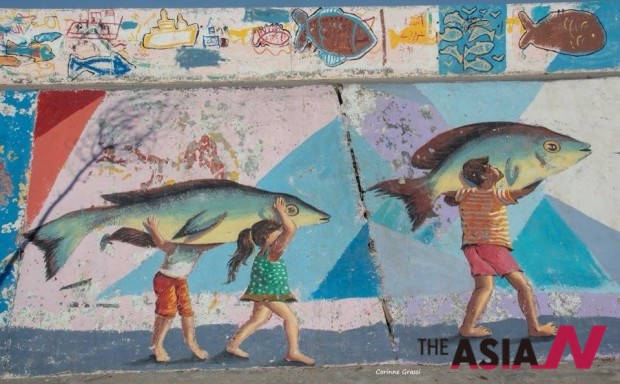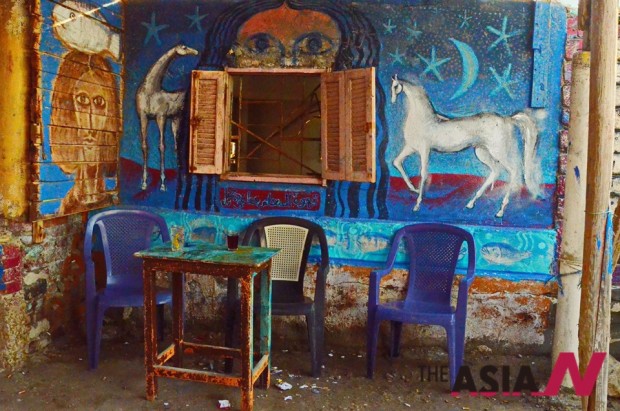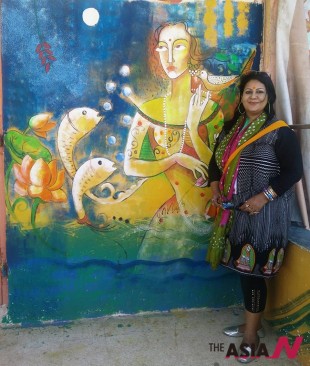예술가 압델 모흐센, 이집트 어촌을 ‘아트 실크로드’ 중심으로
* ‘아시아엔’ 해외필진 기고문의 한글요약본과 원문을 함께 게재합니다.
[아시아엔=아시라프 달리 쿠웨이트 <알 아라비> 매거진 에디터·번역 김아람 기자] 인류의 초기 예술은 어떤 형태였을까? 원시인들이 벽에 사냥 방법을 묘사하고, 중요한 행사 등을 그려 넣던 ‘벽화’가 바로 그 시작이었을 것이다. 그러나 시간이 흐를수록 벽화는 단순한 ‘역사의 기록’이 아닌 예술의 한 분야로 당당히 자리매김했다. 화려한 그래피티부터 시작해 최근 한국에서도 관광지로 각광받고 있는 예쁜 벽화마을까지, 이제 벽화는 어디서나 쉽게 찾아볼 수 있는 장르가 됐다.
여기 이집트에도 벽화로 각광받고 있는 예술가, 압델 와하브 압델 모흐센이 있다. 작은 어촌에서 나고 자란 그는 나무 표면을 조각해 다양한 작품들을 완성해낸다. 주로 목판예술을 해왔던 그가 어떻게 벽화와 인연을 맺게 됐을까? 그는 지난 2014년 자신의 이름을 딴 지역 단체 ‘압델 와하브 압델 모흐센 예술 및 지역 발전 센터’(이하 ‘모흐센 센터’)를 설립한 뒤, 마을을 아름다운 벽화로 꾸미고 주민들에게 예술의 아름다움을 알려왔다. 덕분에 이 작은 어촌은 생기발랄한 곳으로 거듭났다. 모흐센 작가는 “어린 아이를 포함해 마을 주민들과 함께 벽화를 그려 넣는다”면서 “모두 즐거운 마음으로 임하며, 달라진 마을 모습에 다들 좋아한다”고 전했다.
뿐만 아니다. 그는 모흐센 센터를 해외 아티스트와의 교류의 장으로 만들었다. 마을에 그림을 그려 넣는 프로젝트를 진행하면서 이란, 인도, 포르투갈, 요르단, 튀니지 등 다양한 국적의 예술가들의 참여를 이끌어낸 것이다. 작년 10월에 있었던 프로젝트에선 총 10개국에서 25명의 해외 예술가들이 참여했다. 지금까지 아마드 압델 카림, 타리크 엘 코미 등 이집트 출신 작가들을 비롯, 이란의 나세르 팔랑기 작가, 인도의 푸남 찬드리카 트야기 작가 등이 이 프로젝트에 참여했다.
이렇듯 모흐센 작가는 인접국의 예술을 한데 연결하는 ‘아트 실크로드’의 토대를 닦았다. 각국 예술가들은 한 마음이 되어 지역의 예술발전을 이루고, 교류 또한 활발히 진행하고 있다. 설립된 지 3년에 불과하지만, 이집트 정부에서도 지원을 받고 있는 만큼 이 센터는 향후 중동 예술 가교 역할에 큰 부분을 담당할 것으로 기대된다.

Borg El-Burullus: The Silk Road of Art
Painting on walls may have been the first forerunner of all arts. This early art was born when prey hunters’ scribbles recorded the story of hunting and those who lived in the wild painted their life stories round fire, as they illustrated themselves with visual symbols revealing their diaries after returning to their caves after a day’s dramatic journey. Man’s relationship with murals is therefore very close; it has been deep-rooted since those early lines which matured with the development of the murals themselves. Historians, art critics and artists will recognize walls as everlasting exhibitions, whether they exist in the hearts of China’s mountains and are offered by monks to their gods, on the walls of Pharaohs’ tombs where the stories of the dead are recorded, awaiting their resurrection, or on the many architectural achievements in all civilizations in the world’s continents.
As the contemporary experiment of painting on walls is no longer related to history, it has reappeared in more than one form: when popular artists painted words of welcome on house facades to those returning after performing the Haj (pilgrimage). Graffiti painters, known and unknown, have excelled in painting walls with revolutionary ideas; but we are here talking about a third form of painting on walls which represents a new artistic visual journey on the Silk Road of Art.
The experiment carried out by artist Abdel-Wahhab Abdel-Mohsen in the town of Borg El-Burullus, which is surrounded by the Mediterranean and Burullus Lake, was difficult, as it made an extraordinary attempt in a difficult environment, and at a time in which ugliness invaded life and behavior. Consequently, the result has been impressive, as in two seasons, he was able to create the Burullus Forum for Painting on Walls and Boats, a cultural activity in agreement with its societal environment crossing geographic boundaries and promoting the value of art.

I have been monitoring Egyptian artist Abdel-Wahhab Abdel-Mohsen’s career for years, admiring his active steps and distinguished deep vision since he loved and studied art until he became an academic and taught art in Egypt and abroad, in addition to his enlightening role, which stems from his good citizenship. This is clearly shown in his characteristic art exhibitions – which reflect his deep attachment to his homeland, his in-depth critical analysis – and finally, establishing the ‘Artist Abdel-Wahhab Abdel-Mohsen Foundation for Culture, Arts and Development’.
He is a great lover of Burullus Lake, in Kafr El-Sheikh governorate, his birthplace, to the north of Cairo. This love manifests itself in his exhibitions, which portray the surface of the lake, which he frequently paints, without repetition, but in a unique manner using his tools efficiently, aware of the renewal of the lake’s water and faces. But the lake is no longer just water or a geographic sphere; it has become a globe or a planet which Abdel-Mohsen redefines with the details of surfaces and dwellers of its depths and people fascinated by the two elements of formation: water and earth, to which he adds the fire of art and ignites with translucent but revealing, warm and vivid materials like the people he loves. Burullus Lake is located on the Mediterranean coast, 200 km to the north of Cairo. It represents an area of life which provides with its details a space for its people and visitors for contemplation and creativity.
The idea of painting on walls represents the true artist’s communication with his society at a time when points of view prevail that the artist lives in an ivory tower, with his works not reaching the audience, resulting in the artist’s alienation from his society and creating a rift between society and beauty. The experiment has succeeded in a space surrounded by the sea’s and the lake’s natural beauty.
Artist Ahmad Abdel-Karim participated in the Forum for the second year. As we believe that sculptor Mahmoud Mokhtar is the grandson of the great sculptors in the Pharaonic civilization, artists Tariq El-Komi (Egypt) is the inheritor of this legacy which he always revives so as to maintain the glamor of the journey of Egyptian sculpture. He turned his felucca into a great piece of sculpture with three-dimensional layers, probably to relate the story of the felucca, not only of those who took it to the open sea and the heart of the lake, but it also was turned into a historical monument from the ages which we did not live in, representing the concerns of fishermen and the history of El-Burullus.
Artist Alaa Awad, from the new generation, says that the Forum is a unique experience as the art of the street (or painting murals) is a positive expression of society, addressing and communicating with recipients of all types, ages and cultures without an intermediary, in contrast to exhibitions and closed halls. Alaa Awad’s mural portrayed another naval battle from the age of King Ramses III and his war against some invaders coming across the Mediterranean and their alliance with tribes beyond the western border to invade Egypt, as if history repeated itself in the 1956 battle. The painting was not a repetition of the past but rather an artistic attempt to reread it, derive inspiration and learn lessons from it.
Artist Saly Elzaini’s (Egypt) mural brought joy and gained considerable reputation with photographers and featured prominently on the pages of newspapers and periodicals with her child-like spirit, bold colors, combining fascinating decorations of the elements of the environment.

A journey upstream the Nile
As the Nile floats north to its mouth at the end of its journey from its sources, feluccas sailed upstream and moved from the space of Borg El-Burullus to Smart Art Hall, an exhibition in Cairo professionally arranged by Dina Shaaban and Lina Muwafi, as if rebuilding Atlantis.
The boats came back carrying the smell of water and the perfume of breaths, which they poured as they colored them, and under sunlight which covered it during its journey to live a new life with the perfume of new visitors and under artificial lights carrying the smell of nostalgia and the memories of both artists and the public.

Fish, women and legends
The artists’ choice of recurrent ? but neither similar nor identical ? themes may have been inspired by the special magic of the place. As fish appeared elegantly and richly colored in most paintings on walls and boats, women also appeared glamorously spreading joy, and legends were in place with their mystery and pride, as if they were women’s evening tales or men’s stories at open seas.
From such magic emerged the felucca of the Egyptian veteran artist Samir Fuad (aged 72) which carries four women painted in acrylic colors, as legendary figures, while in the background of the painting, fish dance on the bottom of the felucca, as if presenting an Egyptian version of the legend of Achilles’ daughters who in their sweet voices called sailors, and their ships were wrecked because of the coral reefs. The version here is the “caller” who drives out the fishermen or Nile villagers with her voice so they proceed to water where they drown. It is the feminine magic which transcends civilizations, cultures, legends, waters, walls and feluccas.
Greek gods were mixed with themes inspired by Islamic and Coptic arts in the works of Omar El Fayoumi, another skilled artist known for his paintings inspired by Fayoum’s funerary faces.
In the heart of the Mediterranean, Borg El-Burullus lighthouse used to light the journey of the Silk Road of Art and guide artists from India and Iran in the east to Tunisia and Portugal in the west, and from Jordan in the north to Sudan in south, a journey whose sailors believed in the value of their colors and their impact which went beyond the palette and the painting frame to implant delight in the hearts of simple people, stir stagnant water in the art lake and keep the vow with arts which revived and immortalized civilizations.






